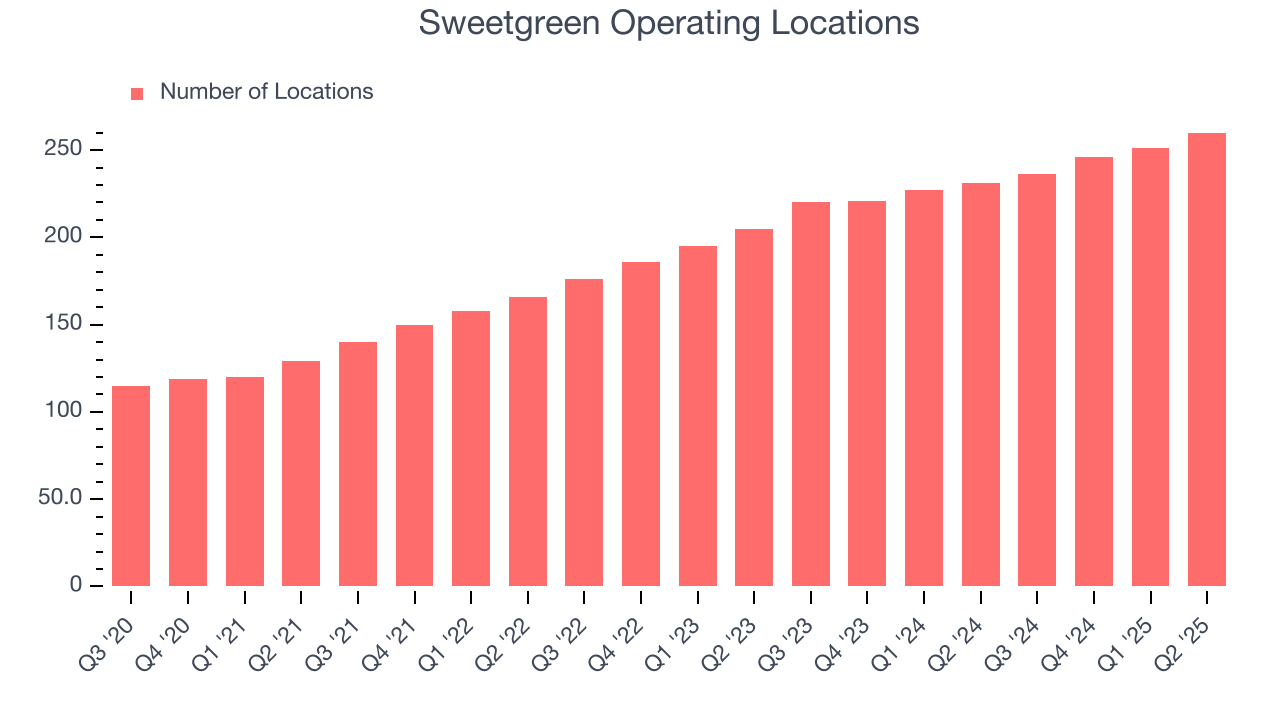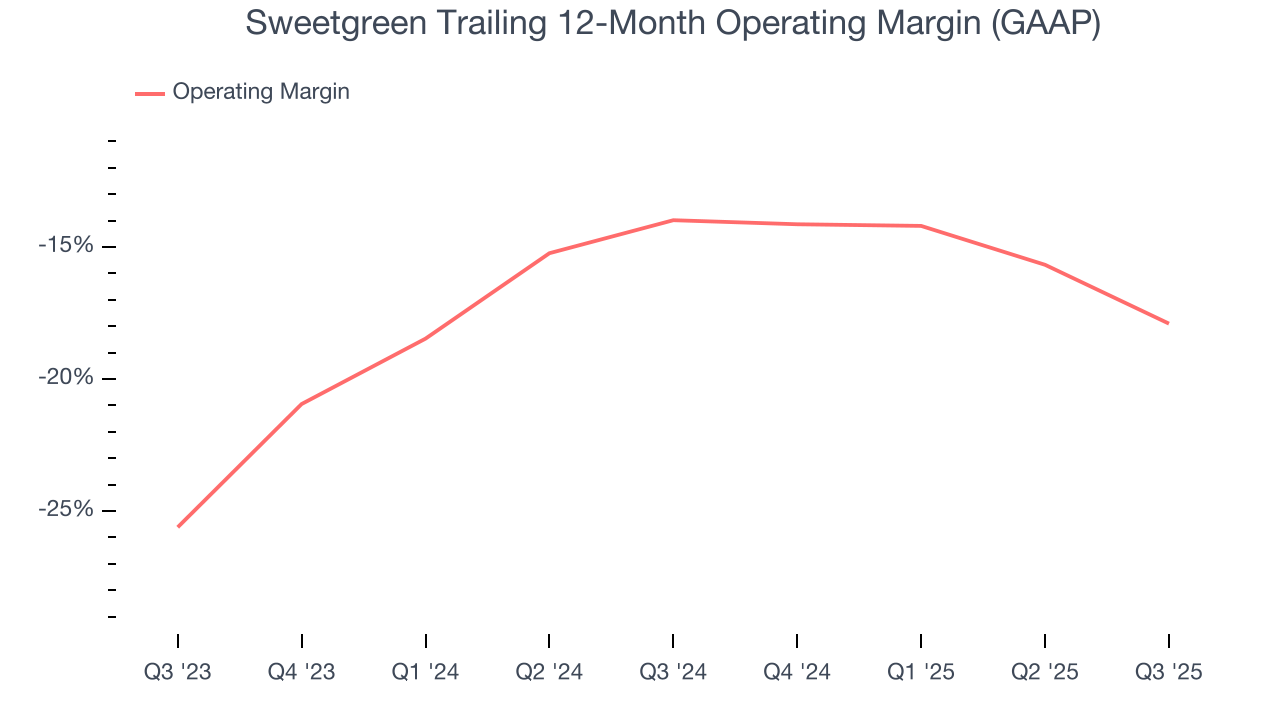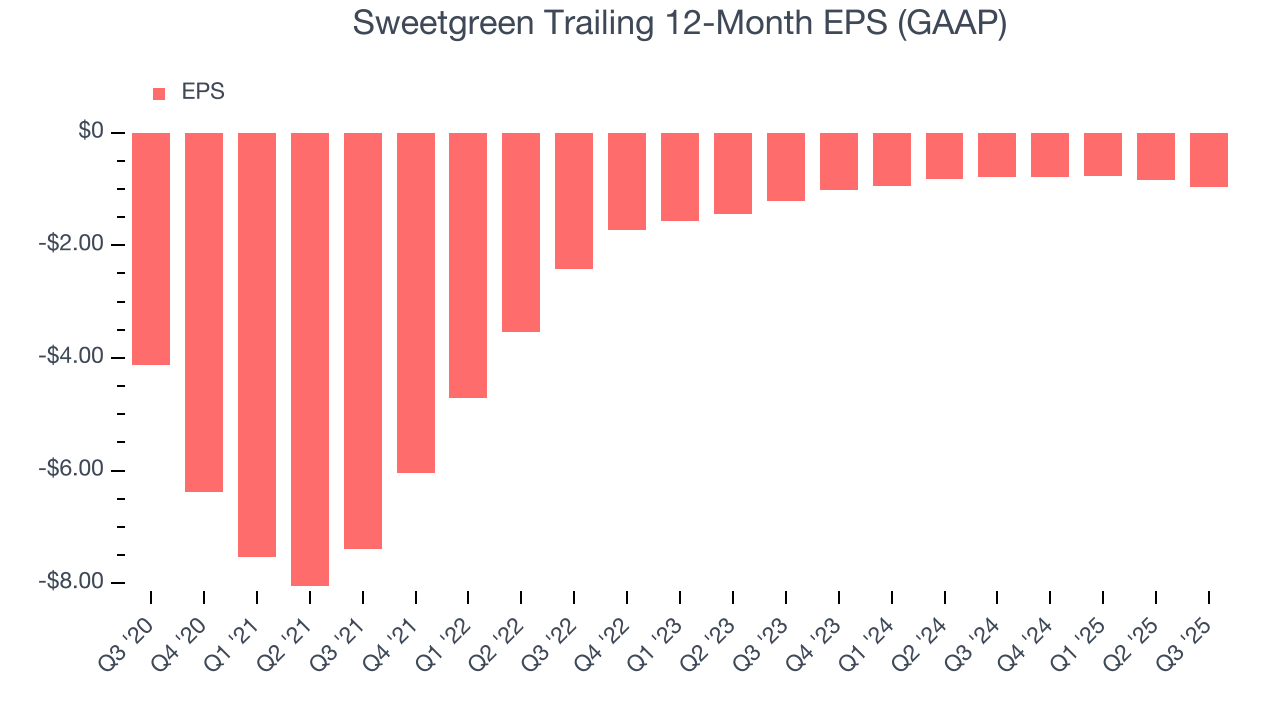
Sweetgreen (SG)
Sweetgreen is up against the odds. Its negative returns on capital raise questions about its ability to allocate resources and generate profits.― StockStory Analyst Team
1. News
2. Summary
Why We Think Sweetgreen Will Underperform
Founded in 2007 by three Georgetown University alum, Sweetgreen (NYSE:SG) is a casual quick service chain known for its healthy salads and bowls.
- Persistent operating margin losses and eroding margin over the last year point to its preference for growth over profits
- Long-term business health is up for debate as its cash burn has increased over the last year
- Limited cash reserves may force the company to seek unfavorable financing terms that could dilute shareholders


Sweetgreen’s quality doesn’t meet our expectations. You should search for better opportunities.
Why There Are Better Opportunities Than Sweetgreen
Why There Are Better Opportunities Than Sweetgreen
At $6.68 per share, Sweetgreen trades at 1.1x forward price-to-sales. The market typically values companies like Sweetgreen based on their anticipated profits for the next 12 months, but it expects the business to lose money. We also think the upside isn’t great compared to the potential downside here - there are more exciting stocks to buy.
It’s better to invest in high-quality businesses with strong long-term earnings potential rather than to buy lower-quality companies with open questions and big downside risks.
3. Sweetgreen (SG) Research Report: Q3 CY2025 Update
Casual salad chain Sweetgreen (NYSE:SG) fell short of the markets revenue expectations in Q3 CY2025, with sales flat year on year at $172.4 million. The company’s full-year revenue guidance of $685 million at the midpoint came in 2.5% below analysts’ estimates. Its GAAP loss of $0.31 per share was 76.2% below analysts’ consensus estimates.
Sweetgreen (SG) Q3 CY2025 Highlights:
- Revenue: $172.4 million vs analyst estimates of $177.9 million (flat year on year, 3.1% miss)
- EPS (GAAP): -$0.31 vs analyst expectations of -$0.18 (76.2% miss)
- Adjusted EBITDA: -$4.36 million vs analyst estimates of $3.99 million (-2.5% margin, significant miss)
- The company dropped its revenue guidance for the full year to $685 million at the midpoint from $707.5 million, a 3.2% decrease
- EBITDA guidance for the full year is -$11.5 million at the midpoint, below analyst estimates of $10.65 million
- Operating Margin: -21%, down from -12.2% in the same quarter last year
- Same-Store Sales fell 9.5% year on year (6% in the same quarter last year)
- Market Capitalization: $764.8 million
Company Overview
Founded in 2007 by three Georgetown University alum, Sweetgreen (NYSE:SG) is a casual quick service chain known for its healthy salads and bowls.
The three thought that the market was missing a so-called fast casual option that offered healthy, fresh, and locally-sourced food. If it was fast, it leaned unhealthy and if it was healthy and fresh, it leaned upscale and full service.
Sweetgreen specifically offers salads and bowls that use fresh, organic ingredients. The ‘Guacamole Greens’, for example, is a cold salad that includes roasted chicken, avocado, and a slew of traditional salad ingredients. The ‘Shroomami’ is a warm bowl that features roasted tofu, warm portobello mushrooms, beets, warm wild rice, and a few other ingredients. You can alter existing menu items with substitutions, and if you’re really not inspired by what’s offered, you can feel free to create a completely custom salad or bowl.
The typical Sweetgreen customer is a health-conscious individual, often a busy millennial who wants a quick and convenient lunch or dinner without breaking the bank. These individuals care about the origin of their food, and Sweetgreen often has a board in their locations showing where each ingredient is sourced, down to the names of the farms themselves.
Sweetgreen’s locations feature a modern and minimalist vibe. Unlike traditional fast-food joints, these stores favor neutral colors, wood and exposed concrete, and plants. To cater to their often tech-forward customers, the company’s app features the full menu along with nutritional information about items. It also allows users to order ahead of time for pickup to maximize convenience and efficiency.
4. Modern Fast Food
Modern fast food is a relatively newer category representing a middle ground between traditional fast food and sit-down restaurants. These establishments feature an expanded menu selection priced above traditional fast food options, often incorporating fresher and cleaner ingredients to serve customers prioritizing quality. These eateries are capitalizing on the perception that your drive-through burger and fries joint is detrimental to your health because of inferior ingredients.
Competitors in the casual quick service industry include Chipotle (NYSE:CMG), CAVA (NYSE:CAVA), Noodles & Company (NASDAQ:NDLS), and private companies such as Chopt Creative Salad and Just Salad.
5. Revenue Growth
Reviewing a company’s long-term sales performance reveals insights into its quality. Any business can put up a good quarter or two, but many enduring ones grow for years.
With $685.2 million in revenue over the past 12 months, Sweetgreen is a small restaurant chain, which sometimes brings disadvantages compared to larger competitors benefiting from better brand awareness and economies of scale. On the bright side, it can grow faster because it has more white space to build new restaurants.
As you can see below, Sweetgreen grew its sales at an excellent 17% compounded annual growth rate over the last six years (we compare to 2019 to normalize for COVID-19 impacts) as it opened new restaurants and increased sales at existing, established dining locations.

This quarter, Sweetgreen missed Wall Street’s estimates and reported a rather uninspiring 0.6% year-on-year revenue decline, generating $172.4 million of revenue.
Looking ahead, sell-side analysts expect revenue to grow 16% over the next 12 months, similar to its six-year rate. Despite the slowdown, this projection is noteworthy and indicates the market sees success for its menu offerings.
6. Restaurant Performance
Number of Restaurants
The number of dining locations a restaurant chain operates is a critical driver of how quickly company-level sales can grow.
Sweetgreen opened new restaurants at a rapid clip over the last two years, averaging 12.8% annual growth, much faster than the broader restaurant sector. This gives it a chance to scale into a mid-sized business over time.
When a chain opens new restaurants, it usually means it’s investing for growth because there’s healthy demand for its meals and there are markets where its concepts have few or no locations.
Note that Sweetgreen reports its restaurant count intermittently, so some data points are missing in the chart below.

Same-Store Sales
A company's restaurant base only paints one part of the picture. When demand is high, it makes sense to open more. But when demand is low, it’s prudent to close some locations and use the money in other ways. Same-store sales provides a deeper understanding of this issue because it measures organic growth at restaurants open for at least a year.
Sweetgreen’s demand within its existing dining locations has been relatively stable over the last two years but was below most restaurant chains. On average, the company’s same-store sales have grown by 1.2% per year. This performance suggests it should consider improving its foot traffic and efficiency before expanding its restaurant base.

In the latest quarter, Sweetgreen’s same-store sales fell by 9.5% year on year. This decline was a reversal from its historical levels.
7. Gross Margin & Pricing Power
Sweetgreen has bad unit economics for a restaurant company, signaling it operates in a competitive market and has little room for error if demand unexpectedly falls. As you can see below, it averaged a 18.6% gross margin over the last two years. Said differently, Sweetgreen had to pay a chunky $81.43 to its suppliers for every $100 in revenue. 
In Q3, Sweetgreen produced a 13.1% gross profit margin, down 7.1 percentage points year on year. Sweetgreen’s full-year margin has also been trending down over the past 12 months, decreasing by 2.6 percentage points. If this move continues, it could suggest a more competitive environment with some pressure to lower prices and higher input costs (such as ingredients and transportation expenses).
8. Operating Margin
The restaurant business is tough to succeed in because of its unpredictability, whether it be employees not showing up for work, sudden changes in consumer preferences, or the cost of ingredients skyrocketing thanks to supply shortages.Sweetgreen has been a victim of these challenges over the last two years, and its high expenses have contributed to an average operating margin of negative 16%.
Looking at the trend in its profitability, Sweetgreen’s operating margin decreased by 3.9 percentage points over the last year. This raises questions about the company’s expense base because its revenue growth should have given it leverage on its fixed costs, resulting in better economies of scale and profitability. Sweetgreen’s performance was poor no matter how you look at it - it shows that costs were rising and it couldn’t pass them onto its customers.

Sweetgreen’s operating margin was negative 21% this quarter.
9. Earnings Per Share
Revenue trends explain a company’s historical growth, but the long-term change in earnings per share (EPS) points to the profitability of that growth – for example, a company could inflate its sales through excessive spending on advertising and promotions.
Sweetgreen’s earnings losses deepened over the last six years as its EPS dropped 13% annually. We tend to steer our readers away from companies with falling EPS, where diminishing earnings could imply changing secular trends and preferences. If the tide turns unexpectedly, Sweetgreen’s low margin of safety could leave its stock price susceptible to large downswings.

In Q3, Sweetgreen reported EPS of negative $0.31, down from negative $0.18 in the same quarter last year. This print missed analysts’ estimates. Over the next 12 months, Wall Street expects Sweetgreen to improve its earnings losses. Analysts forecast its full-year EPS of negative $0.97 will advance to negative $0.69.
10. Cash Is King
If you’ve followed StockStory for a while, you know we emphasize free cash flow. Why, you ask? We believe that in the end, cash is king, and you can’t use accounting profits to pay the bills.
Over the last two years, Sweetgreen’s capital-intensive business model and large investments in new physical locations have drained its resources, putting it in a pinch and limiting its ability to return capital to investors. Its free cash flow margin averaged negative 7.6%, meaning it lit $7.61 of cash on fire for every $100 in revenue.

11. Return on Invested Capital (ROIC)
EPS and free cash flow tell us whether a company was profitable while growing its revenue. But was it capital-efficient? Enter ROIC, a metric showing how much operating profit a company generates relative to the money it has raised (debt and equity).
Sweetgreen’s five-year average ROIC was negative 49.1%, meaning management lost money while trying to expand the business. Its returns were among the worst in the restaurant sector.
12. Balance Sheet Risk
Debt is a tool that can boost company returns but presents risks if used irresponsibly. As long-term investors, we aim to avoid companies taking excessive advantage of this instrument because it could lead to insolvency.
Sweetgreen has $134.1 million of cash and $356.4 million of debt on its balance sheet. Two things are particularly relevant here for investors in high-quality companies: 1) that debt levels aren't too high and 2) that interest payments are not excessively burdening the business.

With $1.76 million of EBITDA over the last 12 months, Sweetgreen’s net-debt-to-EBITDA ratio sits at 126.0x, showing it is overleveraged. We also view its annual interest payments of $4.37 million as high enough to hinder the performance of the business.
If the company’s profitability falls or the market turns unexpectedly, credit agencies could downgrade the company’s rating, making incremental borrowing more expensive and restricting growth prospects. We believe this puts Sweetgreen in a risky situation, something we seek to avoid. We hope Sweetgreen can improve its balance sheet and remain cautious until it increases its profitability or pays down its debt.
13. Key Takeaways from Sweetgreen’s Q3 Results
We struggled to find many positives in these results. Revenue missed on a big same-store sales decline. Its full-year revenue guidance missed and its full-year EBITDA guidance fell short of Wall Street’s estimates. Overall, this quarter could have been better. The stock traded down 7.4% to $5.79 immediately after reporting.
14. Is Now The Time To Buy Sweetgreen?
Updated: December 5, 2025 at 9:49 PM EST
The latest quarterly earnings matters, sure, but we actually think longer-term fundamentals and valuation matter more. Investors should consider all these pieces before deciding whether or not to invest in Sweetgreen.
We see the value of companies helping consumers, but in the case of Sweetgreen, we’re out. Although its revenue growth was impressive over the last six years, it’s expected to deteriorate over the next 12 months and its projected EPS for the next year is lacking. And while the company’s new restaurant openings have increased its brand equity, the downside is its relatively low ROIC suggests management has struggled to find compelling investment opportunities.
Sweetgreen’s forward price-to-sales ratio is 1.1x. The market typically values companies like Sweetgreen based on their anticipated profits for the next 12 months, but it expects the business to lose money. We also think the upside isn’t great compared to the potential downside here - there are more exciting stocks to buy.
Wall Street analysts have a consensus one-year price target of $8.23 on the company (compared to the current share price of $6.68).
Although the price target is bullish, readers should exercise caution because analysts tend to be overly optimistic. The firms they work for, often big banks, have relationships with companies that extend into fundraising, M&A advisory, and other rewarding business lines. As a result, they typically hesitate to say bad things for fear they will lose out. We at StockStory do not suffer from such conflicts of interest, so we’ll always tell it like it is.







